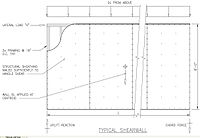
Photo from wikipedia
Abstract Although potential for reduction of energy requirement and related carbon dioxide emissions is highly attractive – around 50% compared to conventional three column sequences – process industries are still… Click to show full abstract
Abstract Although potential for reduction of energy requirement and related carbon dioxide emissions is highly attractive – around 50% compared to conventional three column sequences – process industries are still reluctant to consider implementation of fully thermally coupled four products dividing wall columns, mainly due to concerns related to controllability of two or three vapour splits as encountered in complex DWC arrangements. This paper presents results of a simulation study that could bring some relief in this respect, indicating that a temperature-based control structure, in conjunction with tight control of temperature profiles in prefractionation section, as well as in the product draw regions of the column, is capable of restoring the operation to health from typical disturbances in feed quality and quantity. Combining temperature-based control with two composition controllers enables the column to be operated within finer margins, resulting in minimal over-purification and overall energy requirement.
Journal Title: Chemical Engineering Research and Design
Year Published: 2019
Link to full text (if available)
Share on Social Media: Sign Up to like & get
recommendations!